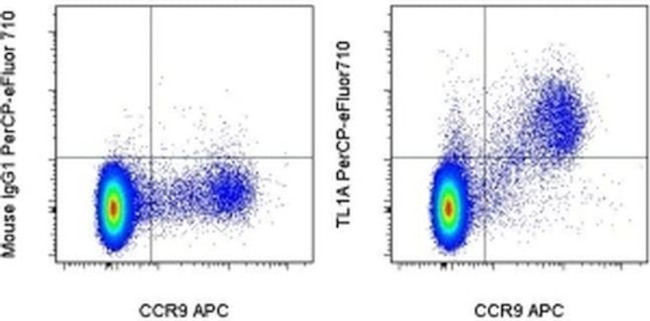Search Thermo Fisher Scientific
Invitrogen
TL1A Monoclonal Antibody (Tandys1a), PerCP-eFluor™ 710, eBioscience™
FIGURE: 1 / 1
TL1A Antibody (46-7911-82) in Flow

Product Details
46-7911-82
Species Reactivity
Published species
Host/Isotype
Recommended Isotype Control
Class
Type
Clone
Immunogen
Conjugate
Excitation/Emission Max
Form
Concentration
Purification
Storage buffer
Contains
Storage conditions
Shipping conditions
RRID
Product Specific Information
Description: The Tandys1a monoclonal antibody reacts with human and mouse TL1A (TNFSF15). TL1A is a member of the TNF ligand family and is expressed by endothelial cells, tissue macrophages, monocyte-derived dendritic cells, plasma cells and lamina propria-derived lymphocytes. Among peripheral blood cells, TL1A has been shown to be expressed predominantly by CD4+CCR9+ lymphocytes. Its expression has been shown to be induced by TNF alpha, IL-1 alpha and IFN gamma. TL1A binds DR3, which has been shown to be specifically upregulated in Th17 cells among CD4+ T cells. TL1A-deficient dendritic cells are weak in their ability to support Th17 cells in vitro and show decreased severity of EAE. In vivo, TL1A has been shown to be upregulated in tissue lymphocytes of Crohn's Disease and ulcerative colitis patients.
Applications Reported: This Tandys1a antibody has been reported for use in flow cytometric analysis, and intracellular staining followed by flow cytometric analysis.
Applications Tested: This Tandys1a antibody has been tested by flow cytometric analysis of normal human peripheral blood cells or mouse splenocytes. This can be used at less than or equal to 0.5 µg per test. A test is defined as the amount (µg) of antibody that will stain a cell sample in a final volume of 100 µL. Cell number should be determined empirically but can range from 10^5 to 10^8 cells/test. It is recommended that the antibody be carefully titrated for optimal performance in the assay of interest.
PerCP-eFluor® 710 can be used in place of PE-Cy5, PE-Cy5.5 or PerCP-Cy5.5. PerCP-eFluor® 710 emits at 710 nm and is excited with the blue laser (488 nm). Please make sure that your instrument is capable of detecting this fluorochrome. For a filter configuration, we recommend using the 685 LP dichroic mirror and 710/40 band pass filter, however the 695/40 band pass filter is an acceptable alternative.
Our testing indicates that PerCP-eFluor® 710 conjugated antibodies are stable when stained samples are exposed to freshly prepared 2% formaldehyde overnight at 4°C, but please evaluate for alternative fixation protocols.
Excitation: 488 nm; Emission: 710 nm; Laser: Blue Laser.
Filtration: 0.2 µm post-manufacturing filtered.
Target Information
The protein encoded by this gene is a cytokine that belongs to the tumor necrosis factor (TNF) ligand family. This protein is abundantly expressed in endothelial cells, but is not expressed in either B or T cells. The expression of this protein is inducible by TNF and IL-1 alpha. This cytokine is a ligand for receptor TNFRSF25 and decoy receptor TNFRSF21/DR6. It can activate NF-kappaB and MAP kinases, and acts as an autocrine factor to induce apoptosis in endothelial cells. This cytokine is also found to inhibit endothelial cell proliferation, and thus may function as an angiogenesis inhibitor. An additional isoform encoded by an alternatively spliced transcript variant has been reported but the sequence of this transcript has not been determined.
For Research Use Only. Not for use in diagnostic procedures. Not for resale without express authorization.
How to use the Panel Builder
Watch the video to learn how to use the Invitrogen Flow Cytometry Panel Builder to build your next flow cytometry panel in 5 easy steps.
Bioinformatics
Protein Aliases: bM20K13.3 (tumor necrosis factor (ligand) superfamily, member 15); MGC129934; MGC129935; TNF ligand-related molecule 1; TNF superfamily ligand TL1A; tumor necrosis factor (ligand) superfamily member 15; tumor necrosis factor (ligand) superfamily, member 15; tumor necrosis factor ligand 1B; Tumor necrosis factor ligand superfamily member 15; Vascular endothelial cell growth inhibitor; vascular endothelial growth inhibitor; vascular endothelial growth inhibitor-192A
Gene Aliases: TL1; TL1A; TNFSF15; TNLG1B; VEGI; VEGI192A
UniProt ID: (Human) O95150, (Mouse) Q5UBV8
Entrez Gene ID: (Human) 9966, (Mouse) 326623

Performance Guarantee
If an Invitrogen™ antibody doesn't perform as described on our website or datasheet,we'll replace the product at no cost to you, or provide you with a credit for a future purchase.*
Learn more
We're here to help
Get expert recommendations for common problems or connect directly with an on staff expert for technical assistance related to applications, equipment and general product use.
Contact tech support

